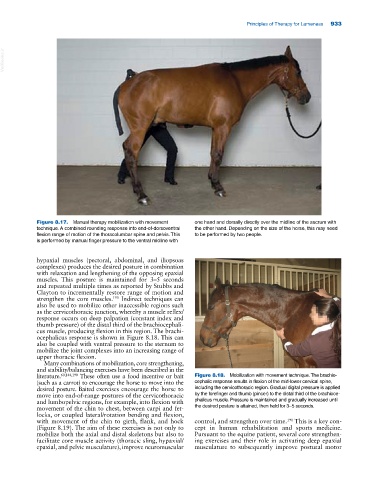Page 967 - Adams and Stashak's Lameness in Horses, 7th Edition
P. 967
Principles of Therapy for Lameness 933
VetBooks.ir
Figure 8.17. Manual therapy mobilization with movement one hand and dorsally directly over the midline of the sacrum with
technique. A combined rounding response into end‐of‐dorsoventral the other hand. Depending on the size of the horse, this may need
flexion range of motion of the thoracolumbar spine and pelvis. This to be performed by two people.
is performed by manual finger pressure to the ventral midline with
hypaxial muscles (pectoral, abdominal, and iliopsoas
complexes) produces the desired posture in combination
with relaxation and lengthening of the opposing epaxial
muscles. This posture is maintained for 3–5 seconds
and repeated multiple times as reported by Stubbs and
Clayton to incrementally restore range of motion and
190
strengthen the core muscles. Indirect techniques can
also be used to mobilize other inaccessible regions such
as the cervicothoracic junction, whereby a muscle reflex/
response occurs on deep palpation (constant index and
thumb pressure) of the distal third of the brachiocephali-
cus muscle, producing flexion in this region. The brachi-
ocephalicus response is shown in Figure 8.18. This can
also be coupled with ventral pressure to the sternum to
mobilize the joint complexes into an increasing range of
upper thoracic flexion.
Many combinations of mobilization, core strengthening,
and stability/balancing exercises have been described in the
literature. 60,144,190 These often use a food incentive or bait Figure 8.18. Mobilization with movement technique. The brachio-
(such as a carrot) to encourage the horse to move into the cephalic response results in flexion of the mid‐lower cervical spine,
desired posture. Baited exercises encourage the horse to including the cervicothoracic region. Gradual digital pressure is applied
move into end‐of‐range postures of the cervicothoracic by the forefinger and thumb (pincer) to the distal third of the brachioce-
and lumbopelvic regions, for example, into flexion with phalicus muscle. Pressure is maintained and gradually increased until
movement of the chin to chest, between carpi and fet- the desired posture is attained, then held for 3–5 seconds.
locks, or coupled lateral/rotation bending and flexion,
with movement of the chin to girth, flank, and hock control, and strengthen over time. 190 This is a key con-
(Figure 8.19). The aim of these exercises is not only to cept in human rehabilitation and sports medicine.
mobilize both the axial and distal skeletons but also to Pursuant to the equine patient, several core strengthen-
facilitate core muscle activity (thoracic sling, hypaxial/ ing exercises and their role in activating deep epaxial
epaxial, and pelvic musculature), improve neuromuscular musculature to subsequently improve postural motor

